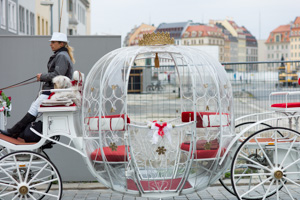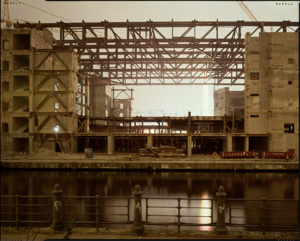Historicism is anything but harmless!
- Written by: Britta Jürgens |
- Created: Tuesday, 04 June 2013 10:50
As an art, architecture must always reflect its Zeitgeist. Now that the construction of a partial imitation of Berlin's destroyed palace has begun, we are witnessing an aggressive attempt to establish historicized facades as the only legitimate approach to our city. In particular the Tagesspiegel has begun a concerted campaign to popularize the idea that a large swath of Berlin's center surrounding the fake palace should also be reconstructed as an imitation of what was there before the Nazis rose to power.
 The journalists and politicians who promote this ideology claim that they are
listening to the will of the people. It is however important to differentiate
between 'the will of the people' and the architects and developers who seek to
exploit this uninformed will for their own purposes.
The journalists and politicians who promote this ideology claim that they are
listening to the will of the people. It is however important to differentiate
between 'the will of the people' and the architects and developers who seek to
exploit this uninformed will for their own purposes.
This is not a harmless stylistic debate; it degrades Architecture from an Art form to decorative skill. The cynical retreat into the safety net of approved geometry has no strength, and no soul. An architect who claims that buildings should refer only to the past, is one who has lost the courage to seek solutions to our current problems. This is the language of a victim, forever damned to endlessly recycle decorative references to a bygone era. Historicism is a refusal to adapt to the continual and rapid disruptive change that is shaking the foundations of our society.
Laypeople could be excused for not understanding the difference between Architecture and historic decoration. However the architects who promote historic decoration as the art of healing our cities are anything but passive executors of the people's will. They are skillful tacticians jockeying for money and power.
 A historicized building needs no explanation, because people are automatically
attracted to what they know. This sugar coating is a simple trick to make a
bitter project easier to swallow. It saves developers the time intensive
process of integrating their project into the city by building relationships
to the public. It also saves the architects the arduous task of designing
something that expresses the time and place in which the building is created.
Instead of this soul searching struggle, the historicizing architect sets a
couple of interns loose to copy and paste from the ossified cultural symbols
built by long dead masters. A few minor adjustments to fit the economic
parameters of the project, and presto, the latest pre cooked meal is ready to go.
A historicized building needs no explanation, because people are automatically
attracted to what they know. This sugar coating is a simple trick to make a
bitter project easier to swallow. It saves developers the time intensive
process of integrating their project into the city by building relationships
to the public. It also saves the architects the arduous task of designing
something that expresses the time and place in which the building is created.
Instead of this soul searching struggle, the historicizing architect sets a
couple of interns loose to copy and paste from the ossified cultural symbols
built by long dead masters. A few minor adjustments to fit the economic
parameters of the project, and presto, the latest pre cooked meal is ready to go.
The real problem is not the uninformed will of the people, but rather the charismatic historicizing architect, who has betrayed his profession in a bald faced pursuit of profit. A few easily formulated but seemingly intelligent theories can back it all up, like the styrofoam behind their imitated facades. Is it really so easy to pull the wool over everyone's eyes?
Fortunately there are a few colleagues who have withdrawn from the competitive treadmill driven by this profitable race to the bottom. They refuse to bend to the will of the investment funds, and populist reminiscences of the past. They have freed themselves from the rusty shackles of our profession, and are operating in cooperative networks to find new solutions to the challenges facing our cities.
This post began as a statement on the bkult debate Ist es harmlos, historisierend zu bauen? (Is historicism harmless?)